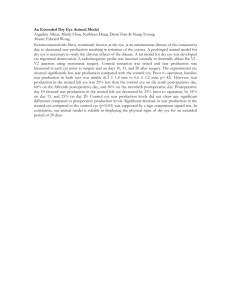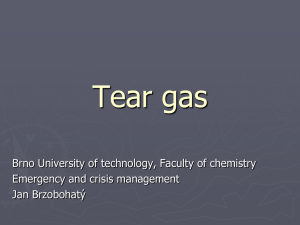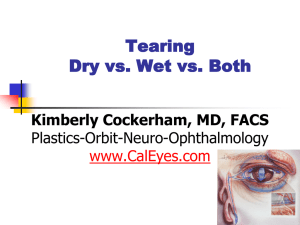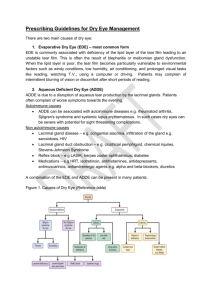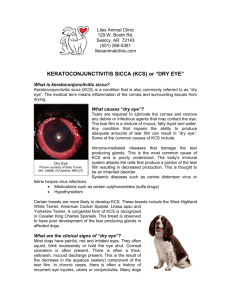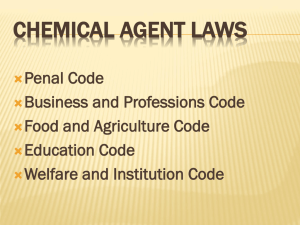DIAGNOSIS AND TREATMENT OF DRY EYE
advertisement
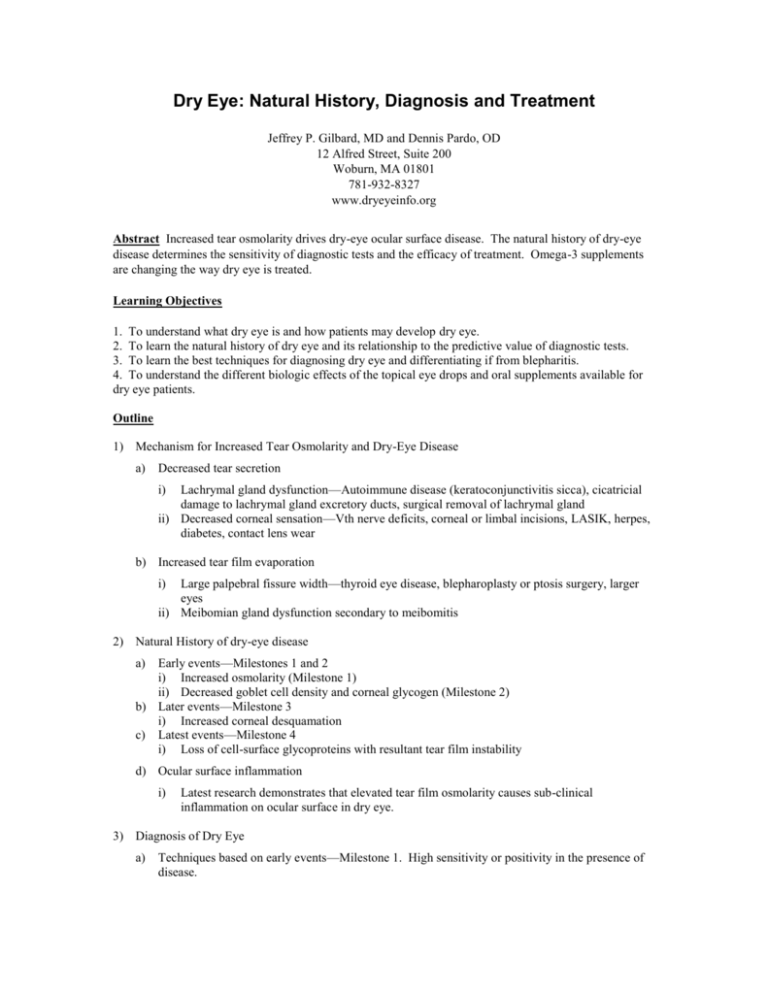
Dry Eye: Natural History, Diagnosis and Treatment Jeffrey P. Gilbard, MD and Dennis Pardo, OD 12 Alfred Street, Suite 200 Woburn, MA 01801 781-932-8327 www.dryeyeinfo.org Abstract Increased tear osmolarity drives dry-eye ocular surface disease. The natural history of dry-eye disease determines the sensitivity of diagnostic tests and the efficacy of treatment. Omega-3 supplements are changing the way dry eye is treated. Learning Objectives 1. To understand what dry eye is and how patients may develop dry eye. 2. To learn the natural history of dry eye and its relationship to the predictive value of diagnostic tests. 3. To learn the best techniques for diagnosing dry eye and differentiating if from blepharitis. 4. To understand the different biologic effects of the topical eye drops and oral supplements available for dry eye patients. Outline 1) Mechanism for Increased Tear Osmolarity and Dry-Eye Disease a) Decreased tear secretion i) Lachrymal gland dysfunction—Autoimmune disease (keratoconjunctivitis sicca), cicatricial damage to lachrymal gland excretory ducts, surgical removal of lachrymal gland ii) Decreased corneal sensation—Vth nerve deficits, corneal or limbal incisions, LASIK, herpes, diabetes, contact lens wear b) Increased tear film evaporation i) Large palpebral fissure width—thyroid eye disease, blepharoplasty or ptosis surgery, larger eyes ii) Meibomian gland dysfunction secondary to meibomitis 2) Natural History of dry-eye disease a) Early events—Milestones 1 and 2 i) Increased osmolarity (Milestone 1) ii) Decreased goblet cell density and corneal glycogen (Milestone 2) b) Later events—Milestone 3 i) Increased corneal desquamation c) Latest events—Milestone 4 i) Loss of cell-surface glycoproteins with resultant tear film instability d) Ocular surface inflammation i) Latest research demonstrates that elevated tear film osmolarity causes sub-clinical inflammation on ocular surface in dry eye. 3) Diagnosis of Dry Eye a) Techniques based on early events—Milestone 1. High sensitivity or positivity in the presence of disease. Gilbard A 2003 Approach to Treating the Dry Eye i) History. Symptoms of chronic (>6 months) sandy-gritty irritation, burning, worse toward the end of the day. Differentiate from meibomitis patients who have sandy-gritty irritation worse upon awakening. ii) Tear osmolarity. Given that elevated tear osmolarity drives the disease process, it is not surprising that this test has extremely high sensitivity. b) Techniques based on early events—Milestone 2. Good sensitivity. i) Fluorescein dye. Use wetted strip. Decreased fluorescence with decreased tear volume; dye highlights debris and dehydrated mucous. ii) Rose Bengal staining. Conjunctival staining precedes corneal staining, nasal staining precedes temporal staining. iii) Impression cytology. Demonstrates decreased goblet cell density. Lab required. c) Techniques based on later events—Milestone 3. Lower sensitivity. i) Corneal staining with fluorescein or rose Bengal dyes. d) Techniques based on latest events—Milestone 4. Lowest sensitivity. i) Tear film break-up time. About 50% of dry eye patients have normal break-up time. e) Schirmer test. Disappointing sensitivity and specificity. i) Conditions that decrease tear production decrease Schirmer test. ii) Meibomian gland dysfunction, while increasing tear osmolarity, increases Schirmer strip wetting secondary to decreased oil absorption on the filter strip. 4) Differential Diagnosis of Chronic Eye Irritation—History, Exam and Testing a) KCS—Decreased tear secretion or increased evaporation b) Meibomitis i) Sandy-gritty irritation worse upon awakening in the morning. c) Other conditions: Lachrymal drainage obstruction, Allergic conjunctivitis, Nocturnal lagophthalmos, Medicamentosa, Superior limbic keratoconjunctivitis, Superficial punctate keratitis (Thygeson’s), Non-specific ocular irritation (smoke, chemicals, etc.), Tarsal foreign body, Normal eyes with hypochondriasis 5) Treatments addressing solely latest events—Milestone 4. Ineffective. a) Preserved lubricants briefly substitute for glycoproteins lost late in disease. 6) Treatments addressing solely later events—Milestone 3. More effective. a) Preservative-free lubricants don’t exacerbate corneal desquamation. 7) Treatments addressing earliest events—Milestones 2 and 1. Most effective. a) TheraTears (Advanced Vision Research, Woburn, MA) shown in pre-clinical studies to restore conjunctival goblet cells and corneal glycogen. Recent study demonstrates accelerated restoration of goblet cells and elimination of dry-eye symptoms following LASIK. Has a tear-matched electrolyte balance and sufficient hypotonicity to effectively rehydrate the tear film and lower elevated osmolarity. b) While punctal occlusion also lowers osmolarity, it has been shown to have no effect on decreased goblet cell density. This is probably due to its inability to correct the goblet-cell-depleting disproportionate increase in tear sodium that occurs with decreased tear production. c) Omega-3 essential fatty acid supplementation. Hypothesized to: i) Suppress meibomitis by generating anti-inflammatory ecosanoids, decreasing proinflammatory ecosanoids, and blocking pro-inflammatory cytokine formation at the gene transcription level. ii) Decrease lacrimal gland and ocular surface apoptosis (programmed cell death). iii) Improve neural signal transduction and lacrimal gland response in the lacrimal gland. iv) Stimulate tear secretion by promoting the formation of PGE1. v) Augment the oil layer by providing the essential fatty acids needed to make healthy meibum. vi) Recent study of 32,470 female health professionals found that the higher the dietary omega-3 fatty acid intake, the lower the incidence of clinically diagnosed dry eye (Trivedi et al. ARVO, 2003,). 2 Gilbard Dry Eye: Natural History, Diagnosis and Treatment 8) The natural history of dry-eye disease dictates the sensitivity of diagnostic tests and the efficacy of treatment. 3
